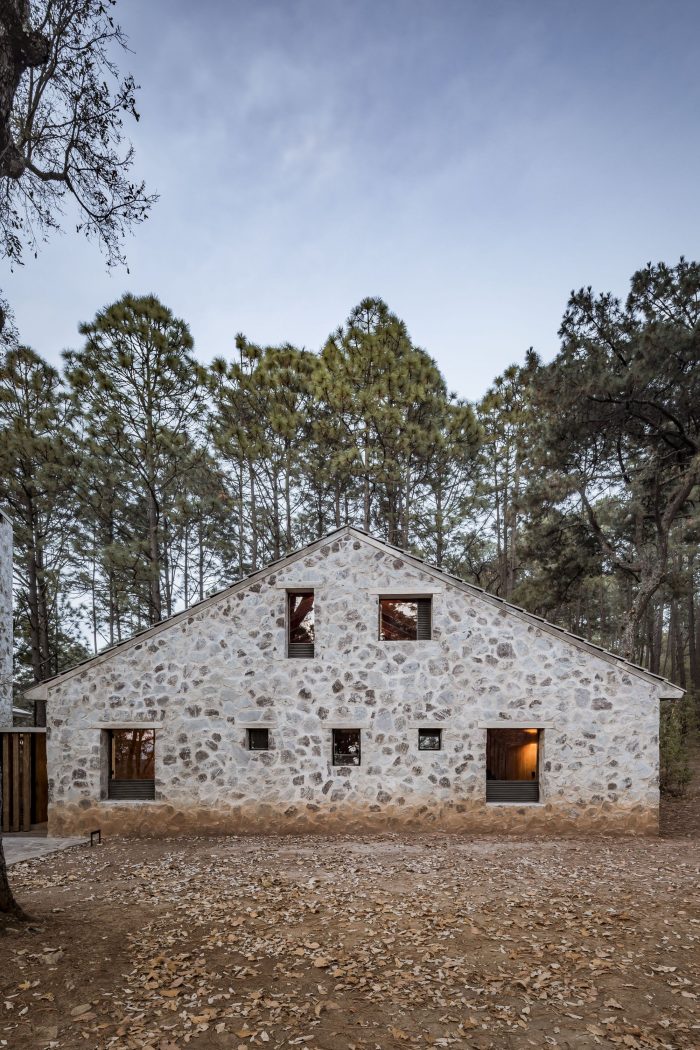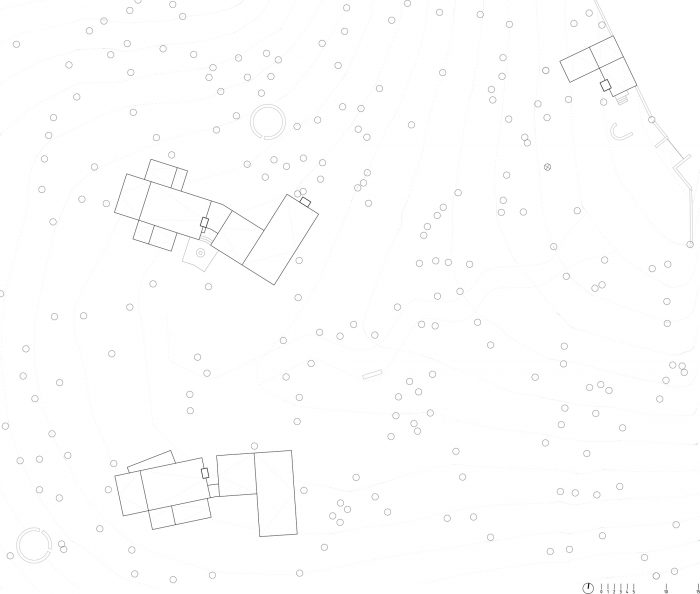穿过圣安东尼奥小镇,走土路上山,进入树林,一切都被留在了那里,里面。
Going through the small town of San Antonio, you take the dirt road to go up the hill and get into the woods, everything is left behind to be there, inside.
松树和一些橡树缩小了视野,并将这里封闭起来,在土地上留下一些空隙。在庄园的入口处,有大门和一间带仓库的小木屋。下坡,你可以看到树木之间的四个卷和一些烟囱,两个小木屋,共同组成一个村庄。
Pines and some oak trees narrow the views and enclose the place leaving a few openings in the land. At the entrance of the property, the gate and a small cabin with a warehouse are located. Downhill, you can see between the trees four volumes and some chimneys, two cabins that together form a village.
石头、混凝土、金属和木头与环境融为一体,它们无所谓地接受阳光和雨水、泥土和时间。这是一个休息、共存和娱乐的地方。在与乡土建筑的连续中,坡屋顶、屋檐、夹层、小窗、前庭和门廊都在寻求对同一事物的回应,重新诠释它们。
Stone, concrete, metal and wood play to merge with the environment, unconcerned they accept the sun and rain, the mud and time. It is a place for rest, coexistence and recreation. In a continuum with vernacular construction, sloping roofs, eaves, mezzanines, small windows, vestibules and porticoes seek to respond to the same thing, reinterpreting them.
节目分为两个:公共区和夜景区,由一座 “桥 “联合起来,同时缩小了通道,将视觉引导到森林中。仿佛树木在施加一些拐点,卷轴微妙地旋转,寻找内部不同空间的视觉和方向,并以破碎的剪影对比背景的垂直框架。
The program is divided in two: the public area and the night area, united by a “bridge” that at the same time narrows the passage and directs the visuals into the forest. As if the trees were exerting some inflection, the volumes rotate subtly searching for visuals and orientations to the different spaces inside and contrast with a shattered silhouette the vertical framework of the context.
小木屋是庇护所,寻求从入口处传送,空间变窄以欢迎并扩展到客厅。规模的变化在不同的空间以及内部路径中都在继续,丰富了体验。
The cabins are shelter, seeking to transmit it from the entrance, the space narrows to welcome and expands into the living room. Scale changes continue both in the different spaces as well as in the inner path enriching the experience.
最后,树木之间的一些壁炉,与那些墙壁的呼应,证实了小木屋想要与森林接触,并能够通过堆砌石头来居住。
Finally, some fireplaces between the trees, echo of those walls, confirms that the cabins want to engage with the forest, and being able to inhabit it by stacking stones.
建筑师:CCOA arquitectura
面积:667平方米
首席建筑师:COA arquitectura
合作者:Diana Quiroz Chávez、Adriana Osuna Maciel、Leonardo Jiménez、Samuel Camacho、Yael Peñuñuri E.、Israel González A
施工:Fabrica
结构工程:CEROMOTION – Juan Jesús Aguirre
国家:墨西哥
Architects: COA arquitectura
Area: 667 m²
Lead Architect:COA arquitectura
Collaborators:Diana Quiroz Chávez, Adriana Osuna Maciel, Leonardo Jiménez, Samuel Camacho, Yael Peñuñuri E., Israel González A.
Construction:Fabrica
Structural Engineering:CEROMOTION – Juan Jesús Aguirre
Country:Mexico


















